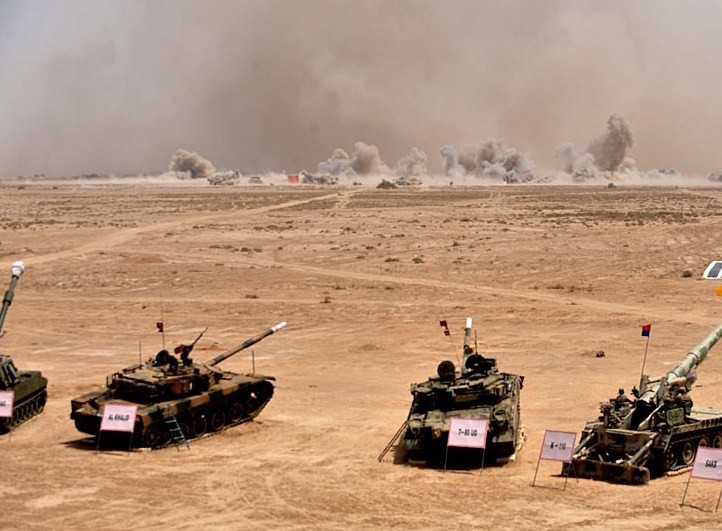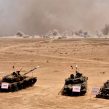
Pakistan’s Ongoing Azm-e-Nau-3 Military Exercises Define Strategic Priorities
Publication: Terrorism Monitor Volume: 8 Issue: 18
By:

For the last few years, the Pakistan Army has been slowly but surely drifting away from fighting the war on terror and placing more stress on building its capabilities to fight its archrival, nuclear-armed India. The process was accelerated when General Ashfaq Pervez Kayani took over command of the Pakistan army in November 2007. His first major act as the new chief of the nuclear armed Pakistan Army was to declare 2008 the “Year of the Soldier”. He took this step to build the morale of the Pakistani soldiers who had become demoralized after fighting their co-religionists for several years in what is called “America’s War.” Later, he declared 2009 the “Year of Training,” ostensibly to prepare the Pakistan army to respond to the Indian “Cold Start” military doctrine of a limited war in the nuclear age.
Addressing India’s Military Planning
India’s defense policy and doctrines had been by and large defensive until it had to fight a limited war against Pakistan in Kargil in 1999. As a newly declared nuclear power, the Indian military started developing new war doctrines to respond to future Pakistani incursions into India. The need for such a doctrine was felt more acutely when Pakistani terrorists launched an attack on the Indian parliament building in December 2001 and the two countries nearly fought another war. The Indian army felt frustrated that it could not invade Pakistan—after a months-long mobilization—because of international intervention. The doctrine of Cold Start, which was announced in April 2004, is aimed at making “shallow territorial gains, 50-80 kilometers deep, that could be used in post-conflict negotiations to extract concessions from Islamabad.” [1] In other words, under this doctrine the Indian army would attack first and mobilize later. Thus, speed of both deployment and operations is a key element of the doctrine.
India has conducted a number of military exercises to test its military doctrine in the last decade. They include Divya Astra (Divine Weapon) in March 2004, Vijra Shakti (Thunder Power) in May 2005, Desert Strike in November-December 2005, Sang-i-Shakti (Joint Power) in March-May 2006, Shatrunash (Destruction of Enemy) in May 2007, Ashwamedh (Valor and Intellectual Illumination) from January to May 2007 and Hind Shakti (Indian Power) in May 2009. Many of these exercises were Pakistan-centric and conducted along the Pakistani border. In most cases, the Indian Air Force was also part of these exercises, meant to test the efficacy of the Cold Start doctrine.
Since taking over the command of the Pakistan army, General Kayani has repeatedly emphasized the threat Pakistan faces from India rather than from a variety of Muslim extremists. In a policy statement, General Kayani said:
"The Pakistan Army is fully alert and alive to the full spectrum of threat which continues to exist in conventional and unconventional domains. Pakistan is not oblivious to the unprecedented acquisition of sophisticated military hardware, synergized with an offensive military doctrine. However, as a responsible nuclear capable state, the Pakistan Army will contribute to strategic stability and strategic restraint as per the stated policy of the government of Pakistan. But at the same time we will continue to maintain the necessary wherewithal to deter and, if required, defeat any aggressive design, in any form or shape, i.e., a firmed up ‘proactive strategy’ or a ‘Cold Start doctrine.’"
More recently, General Kayani said, “We plan [according to] adversaries’ capabilities, not intentions” (Dawn [Karachi], April 5)
Pakistan’s Strategy and the Azm-e-Nau 3 Exercises
The ongoing Azm-e-Nau 3 (New Resolve 3) military exercises appear to be the validation stage of the Pakistani doctrine, developed over the last two years under General Kayani, to counter the Indian Cold Start doctrine (Daily Times [Lahore], April 10). This is clear from the fact that these exercises are taking place near Pakistan’s eastern border in Sialkot, Cholistan and the province of Sindh. In these exercises, the armies of two imaginary states, Blue Land (Pakistan) and Fox Land (India), fight in a war-like situation. In the Azm-e-Nau 3 scenario, the Fox Land army suddenly invades and occupies part of the Blue Land territory (in a “Cold Start” manner). An anti-tank battalion of the Blue Land uses what is called “dispersal tactics” (based on Pakistani military doctrine) to regain territory in an equally swift way (Pakistan Times, May 4). A Dawn editorial summarizes the Azm-e-Nau-3 goals:
"The message the army high command is sending could amount to this: whatever the importance of the fight against the Taliban inside Pakistan and on the western border, the threat posed by the military capabilities of the Indian armed forces remains uppermost in the minds of the generals here. This message will resonate in the American camp too. The generals appear to be reminding the world, especially India and America, that conventional threats — those posed by nation states as opposed to non-state actors — are the greatest long-term threat to peace and stability in the region (Dawn April 20)."
In India, the Azm-e-Nau-3 exercises are seen as the validation of their doctrine. India’s leading Pakistan expert, Sushant Sareen, says, "The Azm-e-Nau exercises really are a validation of the Cold Start doctrine of the Indian army. Clearly, the Pakistan army feels that the Cold Start doctrine as well as the concept of limited war under a nuclear overhang are not as outlandish and impractical as some strategists imagine them to be and that the Pakistan army thinks like this should actually work like a shot in the arm for the Indian army strategists.” [3]
However, a more political but no less important message of the Azm-e-Nau-3 seems to be the further distancing of the Pakistan army from the Americans and the government’s policy of collaborating with the U.S.-led global war on terror, at least as perceived by the public. Some of those who attended the concluding ceremony of the first phase of Azm-e-Nau-3 in southern Punjab were taken by surprise when a drone suddenly appeared in the sky. Within seconds, the anti-aircraft guns of the army shot it down. The pre-planned message was that the Pakistan army is capable of shooting down American drones in the tribal zone (The News, April 19; The Express Tribune, April 19). Although this was no secret to military experts, it raised the national stature of General Kayani in a country where anti-American feelings are rising, which was apparently the intended goal. General Kayani has criticized the drone attacks in the past as well. In what was interpreted as a rebuff to both the Americans and President Asif Ali Zardari, General Kayani strongly criticized America for drone attacks just one day after President Zardari took his oath of office by saying, “There is no question of any agreement or understanding with the coalition forces whereby they are allowed to conduct operations on our side of the border.” He also vowed to defend Pakistan’s sovereignty “at all costs” (Daily Times, September 11, 2008). On other occasions, Pakistani generals have said that they cannot shoot down the intruding American drones without government orders.
Conclusion
Between 20,000 and 50,000 soldiers are taking part in the Azm-e-Nau-3 exercises, which began on April 10 and will finish May 13. They have been described as the biggest ever exercises since 1989, when military exercises codenamed “Zarb-e-Momin” were held. As the Americans were withdrawing from Afghanistan in the wake of the Soviet withdrawal, the then-chief of the Army Staff General Mirza Aslam Beg coined the doctrine of “Strategic Depth” for Pakistan in Afghanistan, under which the Pakistan army supported the mujahideen and later propped up the Taliban. If the past provides any indication, General Kayani may formulate another military doctrine in the light of the Azm-e-Nau-3 exercises in the coming months. The doctrine of Strategic Depth in Afghanistan has played a big role in the radicalization of the region. It is too early to say what kind of doctrine will emerge from these latest military exercises and how it will impact the region and the world beyond. However, taken together, the statements of General Kayani and the Azm-e-Nau-3 military exercises show that the civilian government in Pakistan might find it difficult to achieve a thaw in the region regardless of the sincerity of its efforts in the foreseeable future.
Notes:
1. Walter C. Ladwig, “A Cold Start for Hot Wars,” https://belfercenter.ksg.harvard.edu/publication/17972/cold_start_for_hot_wars_the_indian_armys_new_limited_war_doctrine.html
2. Statement issued by Inter-Services Public Relations (ISPR), January 1, 2010, https://www.ispr.gov.pk/front/main.asp?o=t-press_release&date=2010/1/1
3. Author’s interview with Sushant Sareen May 1.





